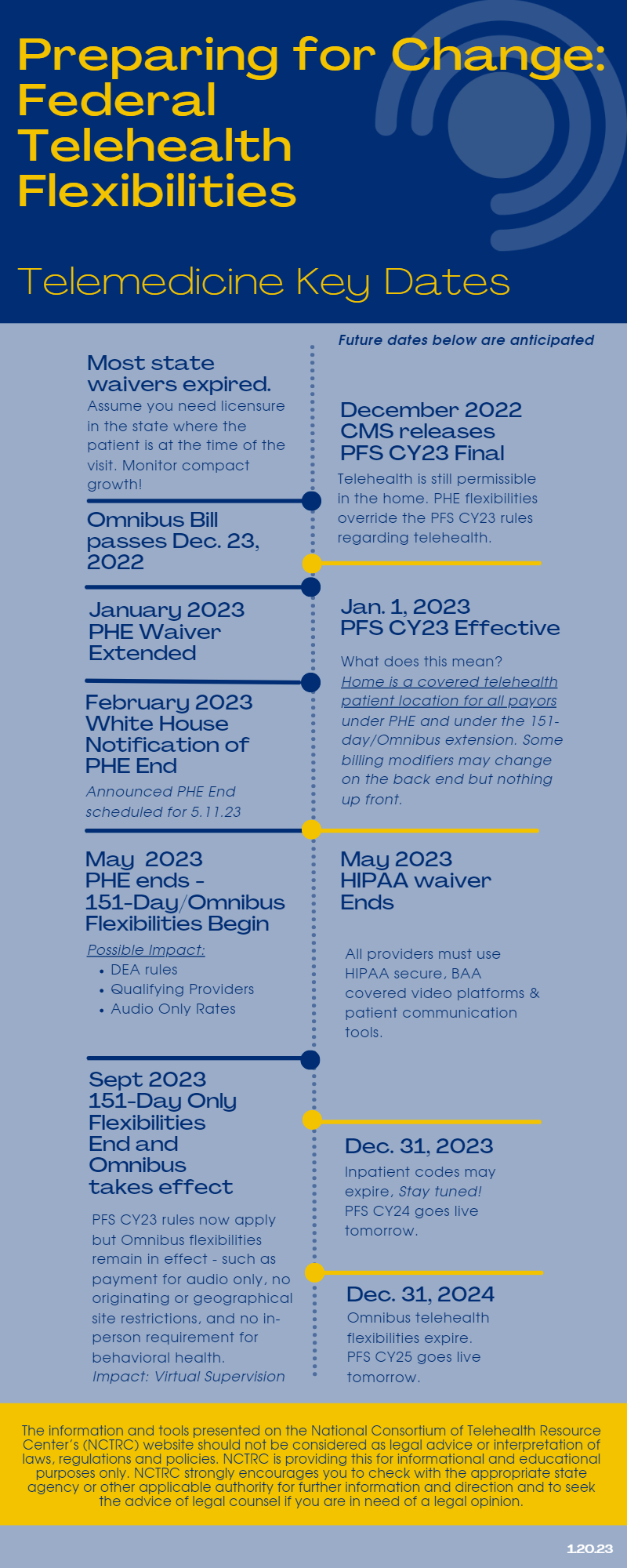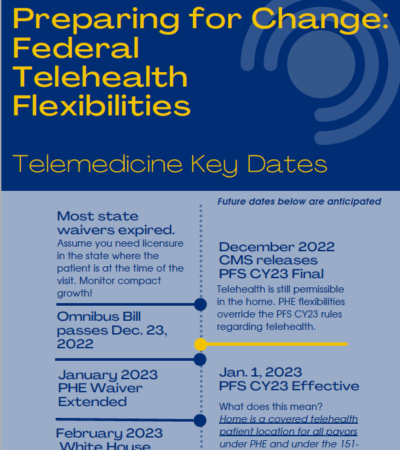Unwinding of the Public Health Emergency (PHE)
Preparing for the end of the PHE – Provider communication
Hi! My name is Rebecca Canino. I am the executive director for the Office of Telemedicine at Johns Hopkins Medicine. We are pleased to partner with the NCTRC to provide a central site for end of Public Health Emergency (PHE) telehealth flexibility planning, which will include blog posts, trusted resource links, tips and tricks, and downloadable tools. I firmly believe that how we manage the uncertainty around the future of telehealth now, amid the incredible pace of change within our health systems, will, in large part, dictate the degree of engagement we will have with our clinicians and patients once the dust settles. We all face the same challenges, let’s navigate the journey together.
Please note: You will need to assess your payer mix to determine the impact of the PHE end to your health system or practice. Keep in mind that most of the PHE flexibilities only impacted patients covered by federal payers (Medicare/Medicaid). Most commercial payers covered video visits in the home pre-pandemic and continue to do so. Coverage for broader telehealth services vary by payer and plan.
For this first blog post, let’s create our provider communications strategy. Our goal is to reassure providers that telemedicine isn’t going anywhere soon. Our communications should be brief, reassuring and as concrete as possible. They should be broadcast broadly around upcoming key dates to lessen uncertainty. It is imperative that we communicate well and often.
What do we know right now? Yesterday, Oct. 13, the PHE was extended for another three months, and we anticipate that by Nov. 12, the White House will send out a 60-day notice of PHE ending on or about Jan. 11. At the PHE end, the 151-day telehealth flexibility extension countdown will begin, and end around mid-June 2023.
Update: Well, November 12th came and went without a 60-day notice. On top of that, the White House has indicated that it will extend the PHE again in January 2023. Should this be the final extension, we anticipate that the White House would send out a 60-day notice of PHE ending in April 2023. At the PHE end, the 151 day telehealth flexibility extension countdown will begin, and end sometime in September 2023.
Update #2: As anticipated, the PHE has officially been extended through April 11, 2023. At this point, we do no think there will be another extension. The Biden Administration stated in 2022 that it would give states 60-day notice prior to the beginning of the PHE, meaning that we should receive official word about the April end date around February 11. However, as part of the Consolidated Appropriations Act signed by President Biden on December 29 was an extension of many of the telehealth flexibilities through December 31, 2024. Stay tuned for Blog Post 3 coming in February that will lay out more of what the new timeline looks like.
Update: #3 The White House announced Jan. 30 it would simultaneously end the COVID-19 national emergency and public health emergency (PHE) declarations on May 11, 2023 so providers have roughly three months to fully prepare for the changes ahead.
What do our providers need to know right now about those dates? Most importantly, they need to know that there are no major changes regarding to whom they can provide telehealth or where. Home is a Medicare-covered location for patients through December 31, 2024 (and most commercial payers don’t have originating site restrictions). Almost all the state waivers have expired, so providers can assume they need licensure in the state where the patient is at the time of the visit. The biggest change for most will be the requirement to use a HIPAA-secure and BAA-covered video platform and patient communications tool by August 9, 2023 (OCR has provided a 90-calendar day transition period for covered health care providers to come into compliance with the HIPAA Rules). Depending on your organization, this could mean a major lift. Now is the time to make sure you (and they) will be ready. Check out Blog Post 2 for more information.
When should they be reminded of these things? We can imagine that there will be media coverage and subsequent flurries of rumors at a few key points — it will be best to get ahead of them with your communications plan. Have your verbiage ready to go on multiple channels: Some options include email announcements, website banners, Listserve, meeting agendas, text alerts and newsletters.

To Do’s:
- Assemble your communications team. (If it’s just you — grab a snack and a Pumpkin Spice Latte, you deserve it).
- Draft brief communications language based on key dates, and get it approved if needed.
- Identify vehicles for communications.
- Set your calendar reminders!
- Be ready to change both the communications and calendars should key dates or legislation shift.
Stay tuned: Next time we will talk about assessing your PHE end risks (always a fun topic).
Talk soon,
Rebecca
Resources:
Disclaimers:
The information and tools presented on the National Consortium of Telehealth Resource Centers (NCTRC) website should not be considered as legal advice or interpretation of laws, regulations and policies. NCTRC is providing this for informational and educational purposes only. NCTRC strongly encourages you to check with the appropriate state agency or other applicable authority for further information and direction and to seek the advice of legal counsel if you are in need of a legal opinion.

